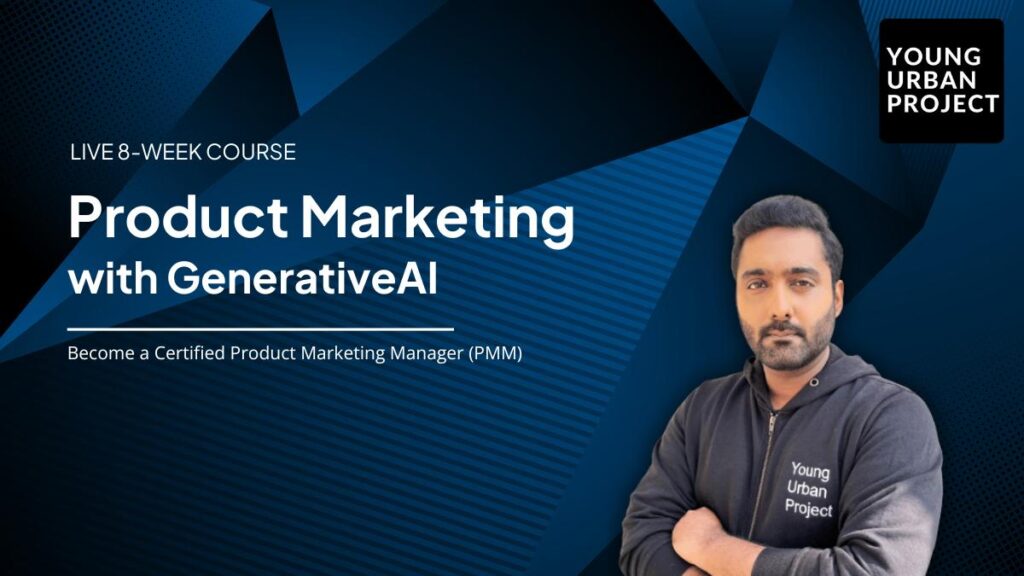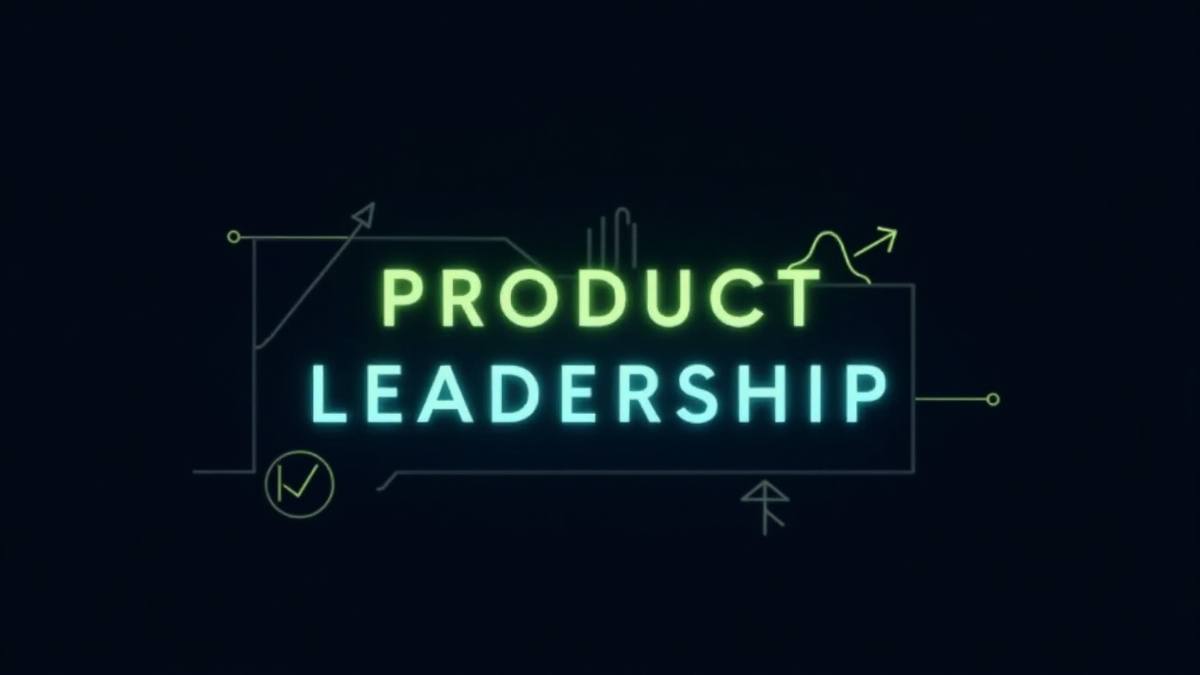You’ve probably come across the term product leadership, maybe in a podcast, a panel discussion, or a Slack thread when someone’s talking about scaling a product team. But let’s be honest, it’s one of those phrases that gets thrown around a lot without always being clearly defined.
So what does it actually mean?
At its core, product leadership is about guiding a product from the seed of an idea all the way to real-world impact. And not just shipping it, but shaping it in a way that delivers real value to users and meaningful results for the business.
It’s not just managing tasks or overseeing timelines. It’s about seeing the whole chessboard, figuring out what should be built, why it matters, and how to align a bunch of different moving parts to make it all happen.
The truth is, even the most talented teams can end up building the wrong thing if no one is steering the bigger picture. Or worse, they might build the right thing… but at the wrong time, or without the right story behind it. That’s where product leadership steps in.
And here’s the thing, this isn’t just another flavor of general management. Product leadership demands a unique blend of skills. You’ve got to think big, stay practical, understand data, and also read between the lines when it comes to customers and teams. It’s vision meets execution, empathy meets strategy.
In today’s fast-moving, AI-powered, always-shifting market, having a strong product leader can literally be the difference between a company that breaks through and one that fades out.
So let’s get into what this role really involves.
Table of Contents
What is Product Leadership?
Let’s cut through the noise. Product leadership is about pulling together people, tech, and user insight to build something that actually solves a real problem, and does it in a way that pushes the business forward.
It’s part strategy, part storytelling, part problem-solving. But above all, it’s about making sure the right product gets built, not just that something gets built.
Unlike a traditional management role that’s focused on keeping things moving day-to-day, product leaders tend to operate at a higher altitude. They ask the harder questions:
- Is this product even worth building?
- Are we moving in a direction that supports our bigger company goals?
- What kind of change are we trying to create for our customers?
Good product leaders live at the crossroads of business, customer needs, and technology. They’re translating across languages, from boardroom metrics to user pain points to engineering constraints. And they’re doing this while juggling ambiguity, imperfect data, and usually a bunch of strong opinions from different corners of the company.
It’s messy. It’s high-stakes. And that’s exactly why it requires someone with clear thinking and solid instincts.
Strategic vs. Tactical: Where Product Leadership Fits In
There’s a common mix-up that happens here: people often assume product leadership is just “senior PM work.” It’s not.
Yes, they both care about products, teams, and customers. But the level of responsibility, and the scope of thinking, is different.
A product manager (PM) is deep in the details. They’re managing features, writing stories, coordinating sprints. They’re focused on execution.
A product leader, on the other hand, is zoomed out. They’re looking at product portfolios, market dynamics, and long-term bets. They’re asking whether the team is even solving the right problem, or if the game itself has changed and the team needs to pivot entirely.
Here’s one way to think about it:
- The PM keeps the train on schedule.
- The product leader decides whether we’re on the right train, going in the right direction… and if the tracks we’re riding even make sense anymore.
It’s about shaping the path, not just walking it.
Also Read: What is Product Concept?
Common Product Leadership Titles & Hierarchy
Depending on the size and maturity of the company, the titles and structures can vary a lot. But here are the most common product leadership roles you’ll come across:
1. VP of Product
Typically found in mid-to-large companies, the VP of Product oversees the entire product org. They translate business goals into product strategy and are responsible for driving cross-functional execution.
2. Head of Product
In startups or lean teams, “Head of Product” may wear multiple hats, from strategy to delivery. It’s often a founder-adjacent role, especially in early-stage companies.
3. Chief Product Officer (CPO)
At the C-suite level, the CPO owns product vision, investment priorities, and alignment with overall business growth. They’re shaping what the entire company should be building.
4. Group/Product Directors
These leaders manage product teams or pods under a larger product umbrella. They focus on cross-team collaboration and aligning multiple PMs towards shared objectives.
Startup vs Enterprise: How It Differs
In startups, one person may be doing all of the above, product strategy, user research, even sprint planning. In enterprises, product leadership is often more layered and specialized. But the core mission stays the same: guiding product efforts toward business success.
Also Read: How to Become a Successful Product Marketing Manager
Responsibilities of Product Leadership Roles
Let’s unpack what product leaders actually do on a day-to-day basis. Hint: It’s way more than running product meetings.
1. Setting Product Vision and Strategy
This is the North Star. A great product leader defines where the product is going, and why. They build a vision that inspires both the team and the company.
2. Managing Cross-Functional Alignment
Product doesn’t exist in a vacuum. Leaders work with design, engineering, marketing, sales, customer success, you name it, to keep everyone rowing in the same direction.
3. Driving Innovation and User Value
Product leaders create space for experimentation. They encourage teams to explore bold ideas, validate assumptions, and continuously improve the user experience.
4. Ownership of Product Outcomes
Not just shipping features, but delivering real results. Product leaders are accountable for metrics like user retention, engagement, revenue, and even market share.
It’s not just about what gets done, but what gets achieved.
Also Read: 11 Great Product Marketing Examples
Product Leadership vs. Product Management
Here’s where a lot of confusion happens. While the two roles are deeply connected, they’re not the same.
| Aspect | Product Manager (PM) | Product Leader |
| Focus | Execution & delivery | Vision & outcomes |
| Scope | Feature-level decisions | Portfolio or company-wide impact |
| Time Horizon | Short-to-mid term | Mid-to-long term |
| Influence | Team-level | Organization-level |
| Success Metric | Product shipped, roadmap velocity | Business results, market impact |
Also Read: Difference Between Product Manager vs Product Marketer
When a PM Becomes a Product Leader
It’s not about years of experience. It’s about how you think. When you start making decisions with the business, customer, and tech lens simultaneously, you’re entering product leadership territory.
It’s less about doing more, and more about thinking differently.

Enroll Now: Product Marketing Course
What Makes a Great Product Leader?
Some leaders are born. Most are built, through experience, failure, learning, and constant refinement. Here’s what separates great product leaders from the average ones:
1. Visionary Thinking
They don’t just follow trends; they anticipate them. A product leader can see around corners, and rally others around a compelling direction.
2. Emotional Intelligence
Handling conflict, navigating stakeholders, and keeping morale high are all part of the game. Empathy and self-awareness are critical.
3. Ruthless Prioritization
With limited resources and time, a product leader must say no far more than they say yes. They focus on what truly moves the needle.
4. Strategic Use of Data
They don’t just “love data”; they know how to ask the right questions, find the right signals, and act on meaningful insights.
And just as importantly, they know when to go with their gut.
Also Read: New Product Development Challenges & How to Overcome Them
5-Step Framework to Lead Products Effectively
There’s no “one-size-fits-all” when it comes to product leadership. But the best leaders I’ve seen follow a kind of informal system, call it a mindset, a rhythm, or a framework, that guides how they lead teams and ship meaningful work.
Here’s a simple 5-step framework that’s been battle-tested in real product orgs:
1. Establish a Compelling Product Vision
This is more than a tagline or a slide deck. It’s a vivid story of the future you’re trying to create, one that connects user needs, market shifts, and company goals.
A strong vision answers questions like:
- What problem are we solving?
- Why now?
- What does success look like in 3–5 years?
This vision becomes the “north star” for the product team, something they can align with when everything else feels chaotic.
2. Align Teams Around Shared Goals
Misalignment kills momentum faster than bad code ever will.
Product leaders create clarity, not just on what to build, but on why it matters. They work closely with design, engineering, marketing, and sales to make sure goals are understood, prioritized, and owned across functions.
If people don’t know how their work ladders up to the big picture, they’ll start filling in the blanks themselves, and that’s when silos and misfires start creeping in.
3. Foster Continuous Customer Feedback Loops
Great product leadership isn’t built on assumptions. It’s built on conversations, prototypes, tests, and patterns from real users.
Whether it’s through interviews, usage data, support tickets, or community forums, product leaders obsess over the voice of the customer. But here’s the trick: they don’t just listen. They act on what they hear, and they create systems for their teams to do the same.
4. Build and Coach High-Performing Teams
This is where leadership becomes less about the product, and more about the people.
Hiring is just step one. Coaching, mentoring, creating psychological safety, recognizing wins (big and small), that’s where real product leaders make an impact. They remove blockers, nurture talent, and give PMs the space to grow.
Some of the best product leaders I’ve met spend more time on people development than product specs. And it shows.
5. Measure Outcomes, Not Output
It’s tempting to celebrate how many features were shipped or how fast a sprint moved.
But product leadership means zooming out. Asking things like:
- Did this actually solve the customer’s problem?
- Did it move our business KPIs?
- Are we learning fast enough?
Impact > activity. Always.
Also Read: Product-Led Marketing
3 Product Leadership Best Practices to Follow
There’s no shortage of frameworks and buzzwords out there. But these three principles consistently show up in high-performing product orgs, regardless of industry or company size:
1. Develop Deep Industry Knowledge
You can’t build great products if you don’t truly understand the customer’s world.
Product leaders should aim to know their users better than anyone else, what motivates them, frustrates them, how they make decisions, and how they define value.
This isn’t about memorizing personas. It’s about curiosity. Getting into the weeds. Listening more than you speak.
2. Continuously Improve Product Processes
Roadmapping. Prioritization. Feedback cycles. Delivery workflows.
All of these evolve as your team scales. Product leadership means treating your process like a product, something that’s constantly being iterated on to work better, faster, and smarter.
Don’t let process become a blocker. Treat it as a living system.
3. Create a Growth-Driven Culture
Teams need permission to fail. To try things. To question old assumptions. That starts with leadership.
Great product leaders invest in learning, experimentation, and team upskilling. They celebrate progress, not just perfection.
The culture they build ends up shaping the products their teams ship.
Also Read: What is a Product Portfolio
Must-Have Skills for Successful Product Leaders
Not every product leader comes from the same background, and that’s okay. But over time, there are certain skills that become absolutely essential if you want to lead at a high level.
Here are a few that matter most:
1. Strategic Thinking
Being able to zoom out, see the landscape, and make decisions that align with long-term business and product goals.
2. Communication & Storytelling
Whether it’s pitching a roadmap, navigating conflict, or rallying teams, the ability to tell a clear and compelling story is non-negotiable.
3. Data Literacy
Not just reading dashboards, but knowing what questions to ask, how to interpret results, and how to use data to influence direction.
4. Change Management
Products evolve. Markets shift. Teams restructure. Good leaders help others navigate through change with clarity and empathy.
5. Conflict Resolution
You will deal with disagreements. Prioritization debates. Stakeholder friction. How you show up during those moments defines your leadership.
How to Grow Into a Product Leadership Role
The leap from individual contributor (IC) to product leader isn’t just about a title. It’s about shifting how you see your role.
Here’s how to make that transition thoughtfully:
1. Start Thinking Beyond Your Product
Ask how your product contributes to the business. Think about customer lifetime value, go-to-market strategy, revenue models. The more you connect product to business, the more you’ll earn trust.
2. Build Influence Without Authority
Product leaders rarely “own” the people they work with. But they lead through influence, by building relationships, being reliable, and communicating a clear vision.
3. Gain Business Acumen
You don’t need an MBA, but you do need to understand how your company makes money, what drives growth, and what keeps executives up at night.
4. Find Mentors & Communities
No one figures this out alone. Whether it’s an experienced product exec, a mastermind group, or a Slack community, surround yourself with people who’ve walked the path — and sharpen your communication skills along the way.
Real-World Examples of Modern Product Leadership
When people think about product leadership, it’s easy to default to big-name tech CEOs, the likes of Elon Musk or Tim Cook. But there’s a new wave of product leaders who aren’t just running established playbooks, they’re creating their own.
These are leaders who deeply understand the complexities of today’s digital-first world: AI-driven experiences, hybrid infrastructure, shifting customer expectations, and rapid scaling challenges. They’re not necessarily the most famous names in tech, but they’re highly influential in shaping how industries evolve.
Let’s look at three standout examples who are leading with clarity, innovation, and a strong grasp of what modern product leadership truly looks like.
1. Jeetu Patel – Chief Product Officer, Cisco
Jeetu Patel currently serves as the Executive Vice President and GM of Cisco’s Security and Collaboration division, but that title barely scratches the surface.
With nearly three decades in enterprise software, Patel blends deep product expertise with go-to-market chops. He’s helped Cisco pivot into a more cloud-first, collaborative, and secure platform, especially relevant in a world of remote work and hybrid teams.
What makes his leadership stand out? He’s not just managing features. He’s architecting systems, secure, scalable ones, that help millions of people stay connected and protected online. And he does it while aligning engineering, sales, and customer success around one clear mission. (Source)
2. Jon Alferness – Chief Product Officer, Walmart U.S.
When you think of innovation, Walmart might not be the first company that comes to mind, but that’s changing, fast. And Jon Alferness is a big reason why.
As Walmart U.S.’s Chief Product Officer and EVP, Alferness leads product strategy across both physical stores and digital platforms, a massive challenge considering Walmart’s size and complexity.
Before this, he led product at Lyft, Varo Bank, and spent over 13 years at Google heading up products for Ads, Shopping, and Travel.
His superpower? Scaling complex marketplaces while keeping customer experience front and center. He’s a master at driving cross-functional alignment across tech, ops, and business, the very heart of product leadership. (Source)
3. Karen Ng – SVP of Product, HubSpot
Karen Ng isn’t just building products, she’s shaping ecosystems.
As SVP of Product at HubSpot, she leads efforts across Smart CRM, Operations Hub, and the broader connected platform. Before this, she worked on some of Google’s most impactful dev tools (like Jetpack Compose) and helped scale product and ML teams at Common Room.
She’s also a former Microsoft product leader, where she played a key role in the Xamarin acquisition, a move that helped modernize mobile development tools.
Ng is a Product 50 winner, holds multiple patents, and brings a rare mix of technical depth, visionary thinking, and people-first leadership. She’s especially known for championing scalable, developer-friendly platforms, the kind that quietly power the tools we all use every day. (Source)
Conclusion: The Future of Product Leadership
Product leaders today aren’t just building features, they’re building companies.
As technology evolves, especially with the rise of AI, no-code tools, and remote collaboration, the role of product leadership will keep changing. But one thing won’t: the need for people who can connect strategy with execution, vision with empathy, and business value with user delight.
If you’re thinking of stepping into product leadership, there’s no better time than now. The world needs bold builders and thoughtful leaders. Maybe you’re one of them.
FAQs: What is Product Leadership
Q1: What is the main goal of product leadership?
To align product strategy with business goals, while ensuring teams deliver customer value effectively and sustainably.
Q2: Is product leadership the same as product management?
Not quite. Product management focuses on execution; product leadership adds strategic direction, cross-functional alignment, and outcome ownership.
Q3: How do I become a product leader without a technical background?
Focus on building business acumen, customer understanding, and communication skills. Many successful product leaders come from non-technical paths.
Q4: What skills are essential for product leadership roles?
Strategic thinking, communication, data literacy, people management, and the ability to influence without authority.
Q5: What’s the difference between a Head of Product and a VP of Product?
Head of Product is often used in smaller or earlier-stage companies. VP of Product typically manages larger teams and holds broader business accountability.
Q6: Can product leaders come from non-product backgrounds like marketing or design?
Absolutely. If you understand users deeply, can think strategically, and know how to lead cross-functional teams, you’ve already got a head start.

